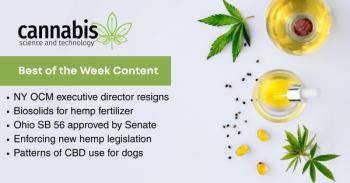
Cannabis Science and Technology
- September/October 2018
- Volume 1
- Issue 3
Microbial Testing in Cannabis: Regulatory and Analytical Challenges
An outline of some of the current major challenges for both regulators and laboratories regarding the microbial testing of cannabis products.
Cannabis testing regulations are constantly evolving with the industry as it grows and gains acceptance. Currently, microbial contaminant testing regulations vary on a state-by-state basis and sometimes are lacking or inconsistent. As a result of the variability and continuous and sometimes hasty changes, the testing of cannabis product for microbial contamination faces constant and evolving challenges. Of the many current challenges facing regulators and laboratories regarding both testing and product safety, the most glaring are varying sample sizes, impossibly short testing deadlines, enumerable product types released to the market, a lack of standardized industry testing conventions, and incongruities in testing requirements. These challenges amount to a sizable regulatory and testing gap in the industry; a gap in which cannabis is tested for contaminants, but the collected data can sometimes lack statistical validity or mislead to assumptions of product safety. Despite these difficulties, numerous industries outside of cannabis have faced and solved similar problems and can offer solutions directly applicable to the cannabis industry. This article outlines some of the current major challenges for both regulators and laboratories regarding the microbial testing of cannabis products. The article is further intended to provide information and resources to aid laboratories and regulators in the eventual resolution of the highlighted difficulties.
Microbial testing in cannabis has become standard practice and a requirement across most states with legal markets. Although the regulations vary from state to state, the general challenges facing microbiologists are more consistent. Rapid regulatory changes and a lack of general consensus on methods seem to be the only true constants. In general, states usually require an array of tests, including total yeast and mold or select mold species identification, Salmonella (<1 colony forming unit [CFU]/g), toxigenic E. coli (<1 CFU/g), total aerobic plate count, total enteric count, as well as other specific bacterial contaminants. But very seldom do state regulations exactly match one another. New York, for example, requires a vast array of testing not seen in other legal states (Clostridium spp., Streptococcus spp., Penicillium spp, Aspergillus spp, and Mucor spp), while Colorado requires only three microbial tests (3,15). These inconsistencies as well as industry lobbying have led to skepticism regarding microbial testing as a legitimate need in the cannabis industry. However, depending on the product type and the end consumer for which the product is destined, microbial testing is absolutely necessary; but it is a valid concern that testing requirements are simply applied to all matrix types regardless of the intended use or consumer.
To add to the complexity, methodologies adopted in various microbial testing categories vary tremendously and include older, tried and true compendial methods adopted from other industries (or variations of compendial methods) that are run alongside innovative new methods which are less heavily vetted. New methods generally are faster and have better sensitivity, but often are not nearly as well tested in application. Although the challenges seem daunting, it is important to keep in mind that every fledgling industry has faced similar challenges and, while cannabis can, at times, appear as though it is completely new, it does have striking similarities to both the food and environmental industries.
Challenges to the Legitimacy of Microbial Testing
“Is microbial testing really necessary?” That’s a question often raised in Colorado.
At first glance, the answer should be a resounding “yes!” but legitimate concerns are being raised about what is being tested for and why. However, a far less valid argument, but one still faced by microbiologists and regulators, is the question: “why test if no one has gotten sick from . . . Salmonella, E. coli, and so on?” While it might be true that contamination of certain products by say, E. coli or Salmonella might be unlikely, “what if’s” must always play a role when analyzing the risks involved with product manufacture and distribution. The cannabis industry is young, and historical outbreak data is extremely limited, but the problems faced by other manufacturing industries are directly similar and it is never acceptable to base testing solely upon what has happened in the past (12). To address the issue of determining appropriate target contaminants in cannabis products, a few basic questions should be considered (12):
- Who is the product destined for?
- What is the likelihood of contamination in the product?
- What impact would there be if the product was contaminated?
- Are there process controls or steps in manufacturing during which contamination is likely controlled?
Although these questions seem like the logical place to start, regulators often are challenged with getting rules into place quickly, typically only months before a product is allowed to be offered for sale. Thus, rules may be drafted and implemented based on worst case scenario only. In fact, draft regulations have even listed criteria for marijuana bud as strict as <1 CFU/g of bile-tolerant Gram-negative bacteria as well as <1 CFU/g for total mold, which would have mandated a product impossible to produce. Current regulations across the country are generally strict and some are arguably overbearing. At the same time, it is almost always better to err on the side of caution and if a product could be destined for immunocompromised individuals (the very old, sick, or very young), then strict testing requirements are indeed necessary (5,12). To aid regulators in promulgating rules that have precedent, the Association of Public Health Laboratories put out an excellent guide outlining potential contaminates in various cannabis product (see Table I) (2). (See upper right for Table I, click to enlarge. Table I: APHL regulatory guidelines.)
Regulators and stakeholders must take into consideration what the food and environmental industries have required for similar items, which are generally based on product type (process type) as well as the end product user. For regulators, it is extremely important to take the proper time to vet these decisions and, if necessary, to contract with the proper consultants who have experience making these types of risk-based evaluations. In general, products intended for adult-use consumers might not require extreme levels of testing; medical products should, however, undergo extremely stringent levels of testing to protect immunocompromised patients (6,11,12). For example, direct inhalation of 102 CFU/g yeast and mold might not be a problem for an immunocompetent individual, but for someone with a debilitating disease, adequate testing and regulatory limits can be the literal difference between life and death (6,11,12).
Regulators also should take into consideration product type with relation to the target analyte being mandated. Although it might not be necessary to test bud intended for smoking for Staphylococcus aureus, it is definitely warranted to test for it in products intended for vaginal or cutaneous use because it can cause skin and soft tissue infections (2). In conjunction with product intended use, it is important to consider outbreaks that have occurred in other industries. For some reason or another, several organisms have rarely been included as cannabis regulatory testing requirements, but should be evaluated in risk assessment. Two prime examples are Listeria monocytogenes and Mucor spp (6,11,). Proper testing must include the appropriate mandated targets and testing for microbial targets must be mandated for the correct reasons. A great example of an incorrect assumption is not testing for Salmonella simply because a product’s water activity is low; low water activity does guarantee stability and bacterial stasis, but it never demonstrates a lack of viable organism. This phenomenon was clearly demonstrated with the 1993 Salmonella outbreak in Germany that occurred in potato chips. More than 1000 people were reportedly affected by Salmonella determined to have originated from dried paprika powder, which after eight months of dry storage still contained 0.7 CFU/g of Salmonella (9).
The other major challenge in the area of proper regulation is testing frequency. Regulatory agencies have, in general, struggled with the amount of cannabis material to require for submission to laboratories-and at what frequency-because of the cost of the product. Although there are other industries from which to draw, as it stands in cannabis, most sampling sizes (where often a single gram is submitted for microbial testing) cannot be considered statistically relevant (16,17). Sampling statistics, regardless of the level of tolerance, must be based on the likelihood of occurrence as well as the risk to the end consumer. The U.S. Food and Drug Administration (FDA) offers guidance and outlines various sample amounts taken for Salmonella depending on food type and intended consumer (6). In compendial microbial sampling protocols, the required sampling amount includes at least 60 subsamples to achieve ~95% confidence in a batch, 30 subsamples for ~90% confidence, and 15 subsamples for ~80% (16,17). Sample sizes are combined to form an analytical unit (generally 25 g or more). However, in cannabis, samples often are too few, not random, and too small. For example, eight subsamples combined to form a composite test sample (even if equaling 25 g) would provide a mere 60% confidence that the batch was not contaminated; or, considered another way, with only eight sample units taken, at least 40% of the entire batch would need to be contaminated with target in order for a positive laboratory result to occur (16). It is strongly recommended that regulators work with experts in the field of microbial sampling and risk analysis to determine the best approach, ensuring that sample sizes and testing have significance. Sample sizes of <10 sample locations providing only a small laboratory sample are not recommended and, in all probability, are meaningless (especially when taking into account laboratory subsampling).
Common Methodological Challenges
The cannabis industry also faces methodological challenges. Turnaround times are constantly pushing test methods to the brink of time limits. Further, microbiology norms are often ignored as the cannabis industry sometimes treats microbial testing as a completely new field. It is important for laboratories to recognize the limitations of microbial testing and follow well established conventions, because these conventions are not exclusive to a single discipline. Turnaround times are probably the larger of the two issues. As clients push for results as quickly as possible, it is tempting to jump on the fastest method that may or may not be able to produce results as accurately as slower compendial methods. With regard to fast laboratory turnaround times, yeast and mold testing is generally the bottleneck, and, as a result, several new methods have come to the forefront in response to the cannabis industry’s call for faster testing.
The most common yeast and mold method used by far are the rapid yeast and mold plates, such as those produced by 3M and IDEXX (SimPlate). It is important, when considering these methods, to validate against seven-day methods in naturally contaminated product to establish that similar results occur regardless of timeframe. It has been shown that faster methods don’t always perform the same as slower methods, especially in products in which the organisms are stressed. One study by Beuchat and colleagues (8) found a difference in performance between 3M Rapid Pertifilms when compared with 3M traditional seven-day films and Dichloran Rose bengal chloramphenicol (DRBC). For certain matrices, 48-h counts could be several logarithms different than those same matrices taken to 72 h or 120 h. For example, the authors found dried banana chips produced <1 log-count yeast at 48 h and 72 h, but around 6-log count of yeast at 120 h (8). Although 48-h counts might work well in some cannabis products, just as 48 h has been shown acceptable in certain food products, it is probable that such short timeframes may not work in every cannabis matrix (13,19).
More modern technology, such as molecular DNA-based methods, offer even faster turnaround times, but the conversion between genomic copies or units (GU) and colony forming units must be further established and shown as statistically comparable. Often, these methods tend to overcount or overestimate certain molds, possibly depending on the number of nuclei found within a single CFU. This problem becomes apparent when presented with molecular data that clearly and accurately counts yeast concentrations, but shows mold CFU counts as double (or more) when compared with agar based methods. This nuclei problem, in all likelihood, could be overcome, but only with very careful conversion calculations. To illustrate this, Figure 1 shows Aspergillus fumigatus nuclei (small red spots identified by the small white arrow in Figure 1e) contained within a single CFU (10). (See upper right for Figure 1, click to enlarge. Figure 1: Differential support of Aspergillus fumigatus morphogenesis by yeast and human actins.)
Molecular methods also have the added challenge of pulling DNA both from only living tissue and spores while simultaneously excluding dead DNA that would not show up on agar based methods. Although there is nothing inherently wrong with any of these methods in theory, it is up to laboratories, regulators, and vendors to ensure the methods produce similar results as compared with more established counterparts (culture-based methodologies).
As mentioned earlier, another common challenge facing the testing of cannabis is a dismissal of microbial conventions-microbiology has certain statistical probabilities and testing conventions that do not match those found in chemistry. It is not appropriate in microbiology to report values with more than two significant figures because certainty drastically decreases past two significant figures. For example, a plate count might indicate 111,111 CFU/g, but the actual “true” value, should the sample be plated to infinity, would be closer to 110,000 (4,18). In addition, it is important to recognize limits of quantitation and detection. It is never appropriate to count plate grids or estimate counts and report this as the actual counted value. Counts such as this require qualifiers such as “greater than” or “estimated” (14,16,18). It also is considered convention to analyze quality controls using logarithmic converted values to account for the natural uncertainty encountered when working with living systems (16). Further, it is convention in microbiology to only retest a sample because of quality control failures-it is never acceptable to retest client samples simply because the client did not like the result. Retests will often produce different results because of storage time and conditions. If a retest is performed, acceptance criteria must be established as to how the retest results should compare with the original result. A change from a result of too numerous to count (TNTC) to a retest value of <1 CFU/g is never acceptable (14).
Molecular methods possess their own established norms and should include important control factors such as internal amplification controls (manufactured in such a manner and provided at a low concentration so as not to compete with target DNA). Newer molecular methods also should be rigorously tested against an array of organisms and matrices to ensure that cross reactivity and false negative are acceptably low (1,5,7). These challenges are, however, easily rectified because conventions exist and are readily available in other industries. It is highly recommended that laboratories adopt microbial conventions as published by the U.S. Department of Agriculture (USDA), FDA, American Herbal Products Association (AHPA), AOAC, and other sources, especially regarding the number of inclusivity and exclusivity organisms required to ensure methods are as robust and well-rounded as possible (1,5).
Matrix Challenges
Cannabis is an unequally challenging matrix and, while the closest relative is probably food, even food is not entirely comparable in terms of product complexity. Cannabis matrices arrive at the laboratory in a vast and endless number of variations. As such, it is immensely important to validate methods to include as many matrices as possible, especially for those that laboratories expect to encounter frequently. Simply assuming a method that works in marijuana bud and brownies will work in “budder” concentrates is not reasonable (5). It is advised to follow AOAC, USDA, and FDA validation guidelines for microbiology as closely as possibly within budget. It may not be possible for a laboratory to validate a method to the level of an AOAC compendial method on a startup budget. Regulators should remember financial limitations are a true and legitimate problem. At the same time, it is always recommended to choose a method that has some basis in other regulatory fields, such as food or environmental, rather than to develop a completely new in-house method from scratch with limited validation funding. It is common in the cannabis industry to attempt the latter; the thinking being that, as cannabis is a new industry, so too must all the methodology be new and proprietary. But an AOAC standard method that includes 100 serovars of Salmonella (50 for other targets) and 50 strains of exclusivity bacteria is always preferred from a regulatory standpoint when compared to an in-house method that was tested against what the laboratory could afford (often less than 10 strains of target and fewer than 10 strains of nontarget) (1). This, of course, is not to discourage the development of new methodology, but care must be taken to ensure method parameters and controls meet those of highly robust and established methods that might only require a matrix extension.
Regardless of the method’s origin, it is extremely important for laboratories to test methodology against as many matrices as possible to weed out potential problems. The use of surfactants is advised for methods designed for the analysis of highly fatty “budders,” waxes, or oils (4). It is important to remember that inhibitory agents are a common occurrence in microbial testing and it is necessary to dilute out potential inhibitory agents. This approach is well known in food and other industries in which, for example, items such as oregano and cinnamon must be well diluted to ensure recovery of the target (ironically, the inhibitory nature of a product does not always protect the consumer from contaminate bacteria) (4,12). The importance of matrix effects must be taken into account. It should never be assumed one matrix represents many or even a few.
Conclusion
Microbial testing in the cannabis industry faces many hurdles, most of which are simply growing pains that will be worked out over time as the industry gains acceptance and conventions are established. Of the challenges outlined, sampling statistics is arguably the most important, but, as more and more individuals with expertise in the area enter the industry, microbial testing will likely be resolved. With regard to sampling, regulators should seek experts-and stand against the industry when necessary-to prevent a potentially unwarranted push to get sample sizes as low as possible, often with no consideration of the threshold at which samples no longer have meaning. As for cannabis testing methodology, methods must be well vetted and, if developed internally, derived from an applicable method available from other fields of testing. As laboratory regulation continues to increase and conventions are reached, microbial testing challenges will be fewer and fewer. However, until that point is reached, the majority of challenges are faced by cannabis laboratories that are directly impacted by fast regulatory changes and are under pressure to keep clients by offering fast turnaround times. Thus, it is important for regulators to keep in mind the impact of rapid testing changes, while at the same time ensuring that regulations have meaning. It is in the best interest of both stakeholders and regulators to work together to ensure testing regulations are meaningful (statistically, logically, and methodologically), and therefore stable, while keeping in mind cost, as well as ensuring consumers receive quality product that is safe for consumption.
References:
- Association of Analytical Communities (AOAC), “Methods Committee Guidelines for Validation of Microbiological Methods for Food and Environmental Surfaces,”
http://www.aoac.org/imis15_prod/AOAC_Docs/StandardsDevelopment/AOAC_ Validation_Guidelines_for_Food_Microbiology-Prepub_version.pdf (2012). - Association of Public Health Laboratories (APHL), “Guidance for State Medical Cannabis Testing Programs,”
https://www.aphl.org/aboutAPHL/publications/Documents/EH-Guide-State-Med-Cannabis-052016.pdf (2016). - “Colorado Retail Marijuana Code,” Adpoted Rules, CCR 1 212-2, Rule 712, Section R 712 – Retail Marijuana Testing Facilities: Sampling and Testig Program, E. Permissable Levels of Contaminats (Adpoted November 17, 2017; Effective January 1, 2018), pp. 124–125.
- US Food and Drug Administration, (FDA), Bacteriological Analytical Manual (BAM),
https://www.fda.gov/Food/FoodScienceResearch/LaboratoryMethods/ucm2006949.htm (FDA, Rockville, Maryland, 2016). - US Food and Drug Administration, Office of Foods and Veterinary Medicine, Guidelines for the Validation of Analytical Methods for the Detection of Microbial Pathogens in Foods and Feeds 2nd Edition,
http://www.fda.gov/downloads/ScienceResearch/FieldScience/UCM298730.pdf (FDA, Rockville, Maryland, 2015). - US Food and Drug Administration, Office of Regulatory Affairs: Inspections, Compliance, Enforcement, and Criminal Investigations, Investigations Operations Manual, Chapter 4 - Sampling,
https://www.fda.gov/downloads/ICECI/Inspections/IOM/UCM123507.pdf (FDA, Rockville, Maryland, 2018). - International Standards Organization ISO 22119 Microbiology of food and animal feed stuff – Real-time polymerase chain reaction (PCR) for the detection of food borne pathogens – General requirements and definitions,
https://www.iso.org/standard/45035.html (ISO, 2011). - L.R. Beuchat and D.A. Mann, J. Food Prot.79(1) 95–111 (2016).
- L.R. Beuchat, E. Komitopoulou, H. Beckers, R.P. Betts, F. Bourdichon, S. Fanning, H.M. Joosten, and B.H. Ter Kuile, J. Food Prot.76(1), 150–172 (2013).
- L.L. LeClaire and J.R. Fortwendel, PLoS One10, 11 (2015).
- M. McCarthy, A. Rosengart, A.N. Shuetz, D.P. Kontoyiannis, and T.J. Walsh, N. Engl. J. Med.371, 150–160 (2014).
- S. Mortimore and C. Wallace, HACCP: A Practical Approach, 3rd Ed. (Springer, Springer New York, 2013).
- P. Bird, J. Flannery, E. Crowley, J. Agin, and D. Goins, J. AOAC Int. 98(3), 1563–1575 (2015).
- R.A. Cowie, Quality Assurance for Microbiology in Feed Analysis Laboratories, (Food and Agriculture Organization of the United Nations, Rome, 2013).
- Rules and Regulations of the State of New York, § 55-2.15 Requirements for laboratories performing testing for medical marihuana (Regulatory Amendments, Effective December 27, 2017), 1004.13 (g) 32-33.
- Y. Salfinger and M.L. Tortorello, Compendium of Methods for the Microbiological Examination of Foods, 5th Edition (American Public Health Association, 2015).
- S. Dahms, ”Microbiological Sampling Plans – Statistical Aspects” presented at the 36th Symposium of the Swiss Society of Food Hygiene, Zurich, Germany (2003), pp. 33–36.
- S. Sutton, Journal of Validation Technologies17(3), 42–46 (2011).
- V.H. Tournas, L. Feliciano, and E.J. Katsoudas, J. Food Saf.30, 506-514 (2010).
Matthew A. Ward is the Marijuana Laboratory Auditor with the Colorado Laboratory Services Division, Department of Public Health & Environment in Denver, Colorado. Direct correspondence to:
How to Cite This Article
M.A. Ward, Cannabis Science and Technology1(3), 22-28 (2018).
Articles in this issue
about 7 years ago
Welcome to Cannabis Analysisabout 7 years ago
Cannabis Uncertaintyabout 7 years ago
The Cannabis Science Conference Grows to New LevelsNewsletter
Unlock the latest breakthroughs in cannabis science—subscribe now to get expert insights, research, and industry updates delivered to your inbox.





